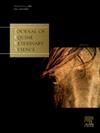有和没有咬床行为的马的粪便微生物组和功能预测图谱:一项比较研究。
IF 1.3
3区 农林科学
Q2 VETERINARY SCIENCES
引用次数: 0
摘要
咬婴儿床是一种刻板的口腔行为,其病因和病理生理学尚不清楚。肠道微生物组与大脑功能之间的关系已在人类精神分裂症、抑郁症和焦虑症等行为障碍中得到描述。而对马的行为问题和微生物组的研究却非常有限。本研究旨在描述患有和未患有食气症的马的粪便微生物组特征以及预测的功能特征。研究人员收集了 12 匹哥伦比亚克里奥尔马的粪便样本,将其分为两组:第 1 组由 6 匹有咬床症状的马(3 雌 3 雄)组成,平均体重为 330±10 千克,年龄为 7.0±1.从两组的每匹马身上获取粪便总 DNA 并对 16S 核糖体 RNA 基因扩增子进行测序,以确定细菌群落结构的特征。群落结构和差异丰度分析表明,两种条件下的差异显著(p本文章由计算机程序翻译,如有差异,请以英文原文为准。
Fecal microbiome and functional prediction profiles of horses with and without crib-biting behavior: A comparative study
Crib-biting is a stereotyped oral behavior with poorly understood etiology and pathophysiology. The relationship between the gut microbiome and brain function has been described in behavioral disorders such as schizophrenia, depression and anxiety in humans. In horses, studies of behavioral problems and the microbiome are very limited. This study aimed to characterize the fecal microbiome and the predicted functional profile of horses with and without aerophagia. Fecal samples were collected from 12 Colombian Creole Horses of both sexes, divided into two groups: group 1, composed of six horses with crib-biting (3 females and 3 males), average body weight of 330 ± 10 kg, age of 7.0 ± 1.2 years and body condition score (BCS) of 5/9 ± 1 and group 2, consisting of six horses without crib-biting (3 females and 3 males), average body weight of 335 ± 5 kg, age 6.5 ± 1 years and BCS of 6/9 ± 1. From each horse in both groups fecal total DNA was obtained and 16S ribosomal RNA gene amplicons were sequenced to characterize the bacterial community structure. Community structure and differential abundance analyses revealed significant differences between the two conditions (p < 0.05). Specifically, the fecal microbiota at the family level in crib-biting horses, showing a decrease in Bacteroidales and an increase in Bacillota and Clostridia, differed from that of healthy horses without crib-biting, consistent with findings from previous studies. Furthermore, metagenome prediction suggests metabolic profile changes in bacterial communities between both conditions in horses. Further studies are required to validate the role of the microbiota-gut-brain axis in the etiology of crib-biting and other abnormal and stereotyped behaviors.
求助全文
通过发布文献求助,成功后即可免费获取论文全文。
去求助
来源期刊

Journal of Equine Veterinary Science
农林科学-兽医学
CiteScore
2.70
自引率
7.70%
发文量
249
审稿时长
77 days
期刊介绍:
Journal of Equine Veterinary Science (JEVS) is an international publication designed for the practicing equine veterinarian, equine researcher, and other equine health care specialist. Published monthly, each issue of JEVS includes original research, reviews, case reports, short communications, and clinical techniques from leaders in the equine veterinary field, covering such topics as laminitis, reproduction, infectious disease, parasitology, behavior, podology, internal medicine, surgery and nutrition.
 求助内容:
求助内容: 应助结果提醒方式:
应助结果提醒方式:


